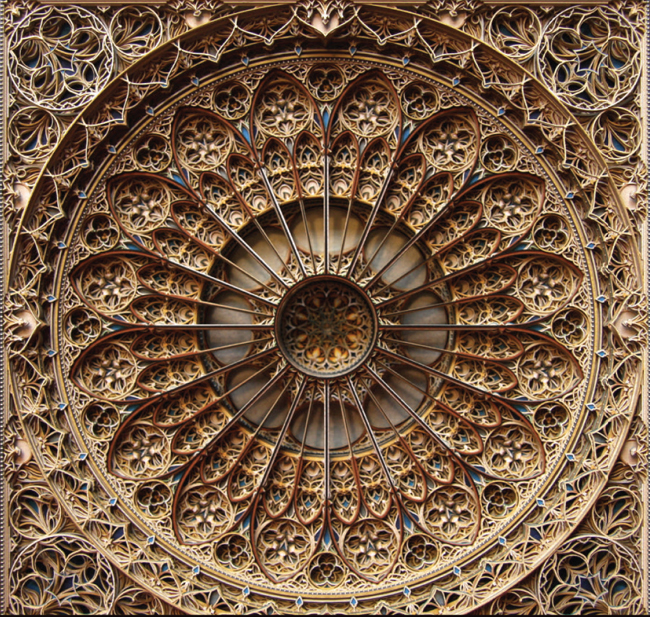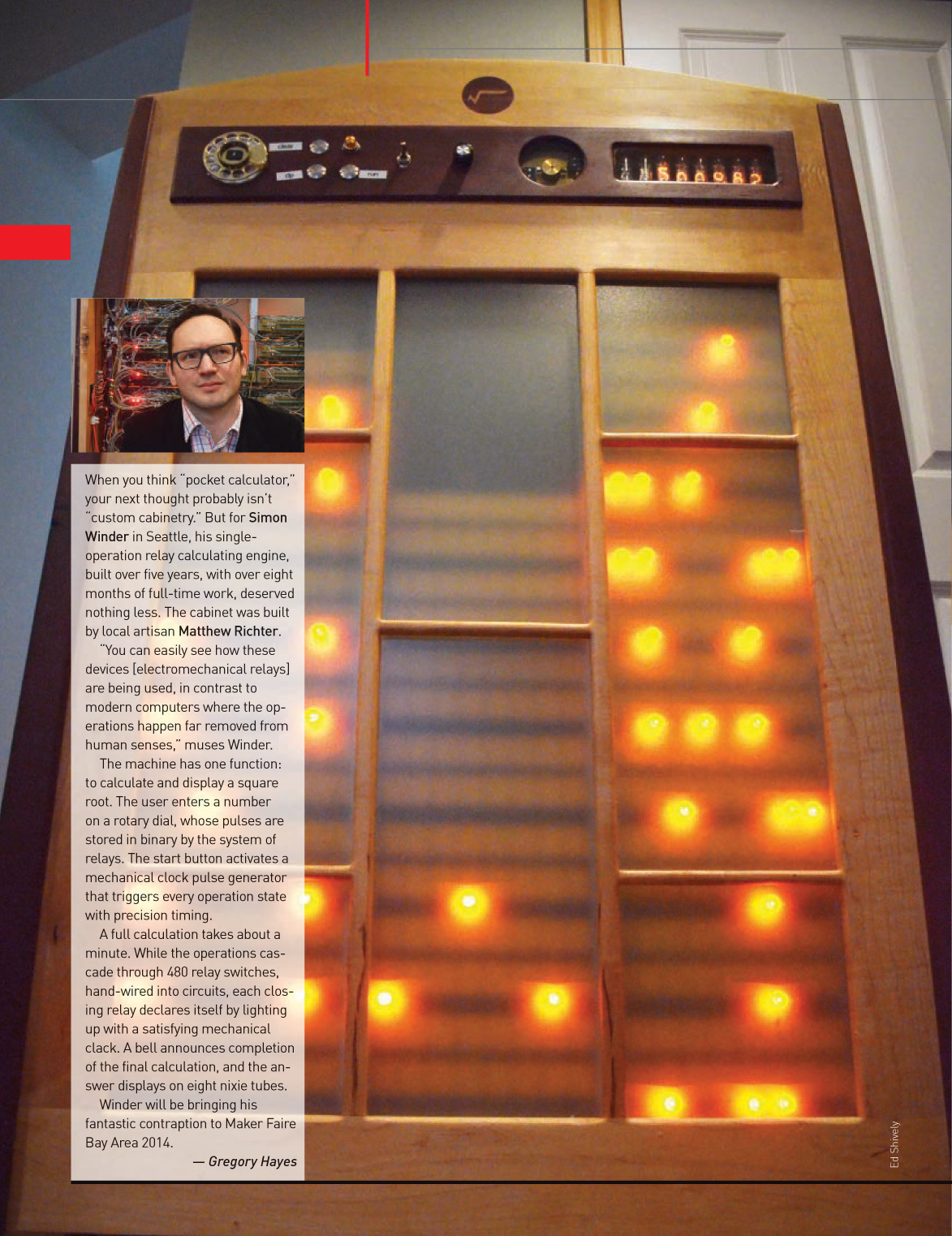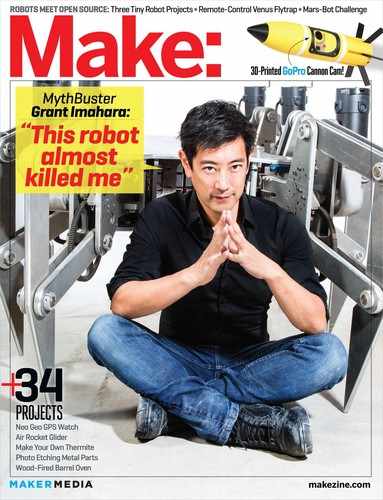MADE ON EARTH
#madeonearth
The world of backyard technology
Know a project that would be perfect for Made on Earth? Email us: [email protected]

Eric Standley
PAPER PERFECT
Virginia-based fine artist Eric Standley is busy blowing minds with his laser-cut paper sculptures reminiscent of impossibly detailed stained-glass windows. Standley spends up to six months drawing and planning each piece, determining depth and obsessively playing with dimension and details.
An associate professor of studio art at Virginia Tech, Standley conceptualized the series by chance while working on a project where he was cutting Cheerios boxes. He decided to try cutting them intricately with the laser cutter and “more or less to be absurd,” he recalls. When he saw the cut sheets stacked atop one another, he found himself drawn in. “To be conscious of drawing on those multiple layers at one time and think about a whole composition with depth, I knew there was something interesting here — I was using a different part of my brain to draw.”
Standley creates vector drawings for each layer before beginning the laser-cutting process, which can take upwards of 60 hours, considering that many of his sculptures use more than 100 sheets of paper. Virtually a paper architect, he must take into account structural elements, implementing curves and overlaps in the design to stabilize unsupported arches. Lest folks think technology is making his task easier, Standley adds, “Every efficiency that I gain through technology, the void is immediately filled with the question, ‘Can I make it more complex?’”
— Goli Mohammadi

IS THAT A TRAIN CAR IN YOUR BASEMENT?

Canadian train enthusiast Jason Shron has a special place in his heart for Via trains, Canada’s intercity passenger rail cars. When he was 12, he wrote Via a letter asking if he could buy a seat from one of the trains, but the return letter said no.
Fast forward to his adulthood, when he heard that Via coach #5647 was to be scrapped. With a group of friends, he was able to salvage it. More than four and a half years and 2,500 hours of build time later, Shron has reconstructed the train car in a 12′×20′ room in his basement complete with all the authentic bells and whistles.
The garbage can, coat hooks, ’70s carpet, radiator covers, folding gate, first aid box, and comfy chairs are all there. He replaced the bathroom with his record collection and sound system, and even added a photomural of the next car that’s visible through the train doors, truly creating the illusion of being on a real train.
To others hoping to follow his lead, he offers, “You, too, can have a train in your basement. You need two things: to be completely insane and to have an amazing wife.”
— Goli Mohammadi



Jason Shron
BUZZ BOOTH

This Audio Bee Booth installation is by Sarah Peebles, assisted by Rob Cruickshank, electronics; John Kuisma, woodworking; and Chris Bennett, pyrography.
Sarah Peebles
Bees are clearly the makers of the insect world. And just like humans, some bees prefer working alone to working amongst the distracting buzz of social collaboration. Luckily, Toronto artist Sarah Peebles and a team of collaborators have created Audio Bee Booths, where native solitary bees (not honey-bees) and wasps can take care of their industrious insect business.
Consisting of a wood nesting plank with different sized grooves routed into it, the booths are designed to accommodate a diverse array of tunneling bee and wasp species. The cutaway side of the nesting plank is covered with a piece of Plexiglas to give visitors a close-up look at the bees’ domestic lives. The booths also feature vibrational sensors embedded in the nesting planks that pick up the sounds the bees and wasps make and amplify them through headphones.
The result is that visitors to the pyrography-adorned Audio Bee Booths are afforded the uniquely intimate experience of hearing and seeing everything that the booths’ reclusive inhabitants are up to.
— Andrew Salomone
+ Learn to make your own solitary bee condos: makezine.com/solitary-bee-condos

Robert Cruickshank
HOMEMADE CLACKULATOR
SIMONWINDER.COM/PROJECTS/RELAY-CALCULATING-ENGINE


REACH FOR THE STARS
SCOTT.J38.NET/INTERACTIVE/REACH

As part of the Tough Art residency at the Children’s Museum of Pittsburgh, designer Scott Garner created Reach, a large-scale interactive mural and musical instrument. When someone touches both the moon and a star, a tone is played. A “triumphant chord” is the result when all of the stars are touched simultaneously.
“Pittsburgh is a city of bridges, so the idea of spanning or reaching across a space came directly from the skyline,” says Garner. “I was also interested in the idea of noncompetitive play, in which a child could accomplish a goal alone, or by cooperating with their family and friends.”
The panels of the installation are constructed of Baltic birch plywood painted in a textured metallic style. To make the aluminum stars, Garner used the water jet cutter at Pittsburgh’s TechShop. “I spent a lot of time filing them down to make them safer for little fingers.”
As for the final result, “After a few tentative taps, kids are often sprawled across the piece, touching stars with all limbs and giggling.”
— Matt Richardson

Kristi Jan Hoover
